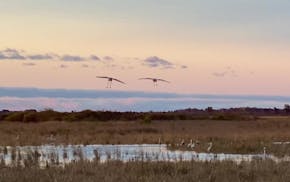Q Can you recommend a flowering tree with no fruit for a garden area?
A There are several small trees that will work well in a garden. While some of these trees do produce dry seed pods or capsules, they don't bear fleshy fruits. Your choice should be based on how much space you have and the growing conditions in your garden.
If you have fairly limited space, you may want to consider some of the increasingly popular patio trees, or what I like to call "shrubs on a stick." These small, formal-looking plants are created by grafting or training shrubs into tree forms.
If you'd like a perfect garden lollipop try tree-form dwarf Korean lilac (Syringa meyerii 'Palibin'). This is a small lilac -- normally a tidy, rounded, 3-foot-tall lavender-flowered shrub -- that is grafted on a standard (an understock plant that is grafted about 3 to 5 feet up the trunk instead of near ground level). In this case Japanese tree lilac (Syringa reticulata) is used as the standard.
Other flowering shrubs available in this small tree form include Tinkerbelle lilac, double flowering plum (Prunus triloba), weeping peashrubs (Caragana arborescens 'Walker' and 'Pendula'), and panicle hydrangeas (Hydrangea paniculata 'Tardiva' and 'Grandiflora').
If you have more room consider a redbud, Japanese tree lilac or star magnolia. Redbud is admired for its show of pinkish purple flowers in spring, its glossy green heart-shaped leaves and its picturesque form. It's essential to pick a redbud from a hardy seed source, since Southern-source redbuds will not be hardy here. Look for words such as "Minnesota strain,"Wisconsin strain" or "Northern strain" on the label or ask the nursery about its source. Redbud grows 15-20' tall in sun or partial shade and needs evenly moist soil with lots of organic matter.
Japanese tree lilac (Syringa reticulata) bears large clusters of tiny, ivory-colored flowers in early summer. This 20- to 25-foot-tall tree is often low-branching or multi-trunked, giving it an attractive form in winter. Japanese tree lilac grows best in full sun and tolerates a range of soil conditions. In addition to making a charming garden tree, Japanese tree lilac is also a great choice for street or boulevard plantings.
Star magnolia (Magnolia stellata) is a lovely small tree (just 10 to 15 feet tall in our climate) with a neatly rounded outline. Blooming early in the spring, star magnolia's lovely multi-petaled white flowers are occasionally nipped by a late frost. Grow in full sun or partial shade in moist, well-drained soil. This is an elegant choice for gardens and patios.
Q What are some flowers and shrubs that I can plant in raised beds on the west and south sides of my house? The beds are in full sun.
A You'll need to determine a few things about your planting beds before selecting plants. Are the beds attached directly to the house? The soil in planters that are in direct contact with the house may stay slightly warmer in the winter, which can help protect plants' roots from freezing damage.
How high are the raised beds? If the beds are raised only a foot or so above the surrounding ground level there is less chance of freezing damage to roots. If the beds are taller, say 3 feet, the plants' roots are more subject to freezing because they are farther away from the temperature-moderating effects of the mass of the surrounding ground. Plants in tall, narrow raised beds are particularly susceptible to freezing damage since so much of the outside of the planter is exposed to sub-zero winter temperatures.
While the branches of a shrub might be able to survive air temperatures of 30 below zero, the roots of even hardy plants can be damaged when soil temperatures dip below about 25 to 27 above zero. If your planting beds are tall and exposed, perennial flowers and shrubs may not survive the winter in them. In that case, you may need to just plant annuals.
Let's assume that perennials and shrubs will be able to survive winter in your raised beds. Now we have to think about the growing conditions in the beds during the summer. One advantage of raised beds is that the soil in them usually drains well. The disadvantage is that the soil dries out more quickly than the ground, because the soil in the planter is more exposed to heat and wind.
Even if you water the beds regularly, you'll still want to select plants that can tolerate drier soils. They'll be better able to survive heat waves or a watering lapse. The box at left lists small shrubs, perennials and annuals that should do well in your raised planting beds.
Nancy Rose is a horticulturist, writer and photographer. To ask her a gardening question, call 612-673-9073 and leave a message. She will answer questions in this column only.
Shrubs: Potentilla (Potentilla fruticosa) Pawnee Buttes Western sand cherry (Prunus besseyi 'Pawnee Buttes') Bush honeysuckle (Diervilla lonicera) Ames St. Johnswort (Hypericum kalmianum 'Ames') Gro-Low fragrant sumac (Rhus aromatica 'Gro-Low') New Jersey tea (Ceanothus americanus) Broadmoor juniper (Juniperus sabina 'Broadmoor')
Perennials: Butterfly weed (Asclepias tuberosa) Poppy mallow (Callirhoe sp.) Penstemon Blazing star (Liatris sp.) Purple coneflower (Echinacea purpurea) Yarrow (Achillea) Creeping sedums Coreopsis Artemisia Prairie dropseed (Sporobolus heterolepis) Annuals: Sunflowers Gazania Creeping zinnia African daisy Dahlberg daisy California poppy Moss rose (Portulaca) Annual vinca Verbena
Sign up for Star Tribune newsletters

Sandhill cranes coming to roost
Oscar-winning actor Maggie Smith dies at 89

